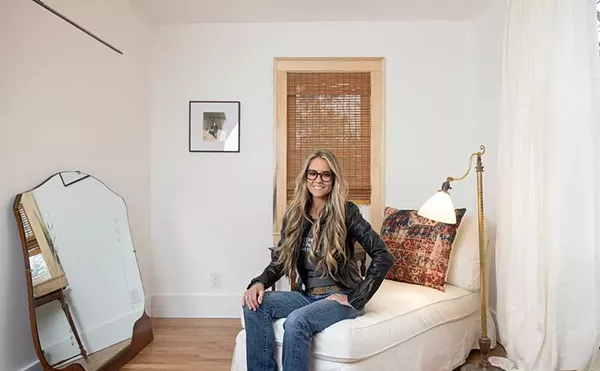
Audio By Carbonatix
[
{
"name": "GPT - Leaderboard - Inline - Content",
"component": "35519556",
"insertPoint": "5th",
"startingPoint": "3",
"requiredCountToDisplay": "3",
"maxInsertions": 100,
"adList": [
{
"adPreset": "LeaderboardInline"
}
]
}
]
Sit on me. Curl up on my fine lines. Take a load off. Or just sprawl out and admire me.
Forget the no-touch policy you are accustomed to at most galleries. This art — chair art — practically begs you to get physical with it, from a modified grocery cart titled “Manager’s Special” to a concrete bench on wheels called “Daydreams from the Curb” to a cushion-topped toilet bowl named “Smoking in the Boy’s Room.”
In an effort to follow in the illustrious groove carved out by Cranbrook Academy of Art designers and architects, 20 students from 10 Cranbrook departments are presenting one-of-a-kind functional seating creations in the third annual exhibit dubbed Seating Arrangements. This year, the show is at Detroit’s relatively new 4731 Gallery on Grand River Ave.
The exhibit is a nod to Cranbrook’s rich legacy of furniture design. In the early 1930s, the school’s first president, Finnish architect Eliel Saarinen (who designed the Academy and is famous for his “Side Chair”), attracted an illustrious group of artists and craftsmen who had a major impact on 20th century design.
Among the international icons who hallowed the school’s halls were Eero Saarinen (Eliel’s son), husband-and-wife team Charles and Ray Eames, Harry Bertoia and Florence Knoll, to name a few.
“They were the real superstars of mid-century modern chair design,” says Scott Klinker, head of Cranbrook’s 3-D design department.
In the ’30s, Eero Saarinen collaborated with Charles Eames, producing several highly successful furniture designs, including Saarinen’s famed “Tulip Chair.” By the late ’40s, Charles and his wife, Ray, created their molded plywood chairs and the renowned “Lounge Chair,” now in the permanent collection of the Museum of Modern Art in New York.
In 1950, Bertoia, who also worked with the Eameses, introduced his famous “Diamond Chair,” made of welded steel latticework. And Florence Knoll forever influenced the look and function of American office interiors through her design firm, Knoll International. These “superstars” of art and design benefited from the international rise of modern architecture.
“It was the right talent and the right time. They made magic happen,” says Klinker.
Seating Arrangements hopes to follow the masters’ lead. With more than 30 chairs on display, priced at $200 to $10,000 each, the show falls into three themes, says Bradford Watson, an architectural grad student and the show’s curator.
The first uses found objects as the impetus for design, rethinking objects in our world. “Manager’s Special” is a former shopping cart, painted white with a bright pink cushion, created by Mike Andrews, a sculptor, along with Alexandria Carrion, who works with metals. The piece harks back to childhood memories of rides through supermarket aisles.
“That thing we use on a daily basis, now within the context of how we relax at the end of the day, completely shifts the way in which we typically perceive the shopping cart,” says Watson. (Yes, especially when we see the $4,000 price tag.)
Architecture student Robert Brooks made three benches, all shaped like a thin, slightly curved slice of pizza. A piece of a satellite dish Brooks found in a Royal Oak salvage yard sparked the design; the dish part became the seat of a lime green bench dubbed, “Waiting for Fireflies.” That piece inspired the concrete “Daydreams from the Curb,” which sits just off the floor, and a lipstick-red wood bench of the same form.
“There was something so appealing about the shape, just the possibility of lounging and reclining,” says Brooks.
Another theme is the exploration and exploitation of materials, exemplified by Watson’s stainless steel and Brazilian cherry wood dining chairs, aptly named, “18,” after the 18-foot bands of steel carefully bent to create each chair.
“That thin ribbon of steel, that is so limp when it’s folded, becomes very rigid, yet still relaxes,” explains Watson, still fascinated by the process. Displayed three across from each other at an imaginary dining table located in the building’s former vault, the chairs are surprisingly comfortable.
In the same room, at the heads of the imagined table, are sculptor Tonya Stewart’s ash wood “Tall Chairs,” representative of Watson’s third theme — that of rethinking the chair as an icon we live with. Very tall backs and very short seats give Stewart’s works a whimsical quality, and leave your feet reaching for the floor.
To see the chairs together in the intimate setting, you feel as if a dinner party is about to begin.
“The chairs speak to each other,” offers Watson softly, almost listening.
Another chair, “(A)typical Stool” by 3-D design student Jason Cornelius, incorporates birch plywood and a flat panel TV for a dual function seat. At once simply a cushion atop a square table, the pieces are reinvented through reorganization. By placing the cushion on the floor and tipping the table on its side, from which a TV is displayed and can be watched, you’ve got a new perch from which to watch the boob tube.
Jeewon Jung’s humorous “Smoking in the Boy’s Room” takes a toilet bowl, painted silver, adds a built-in ashtray and a chic turquoise leather cushion — presumably meant to be straddled backwards, facing the would-be tank.
And Cas Holman’s, “4 Man Chairs, 1 Bench,” has to be seen to be appreciated. Bright orange and red splotches sprawled across four white chairs at first appear to be abstract. Look closer, or as Watson cautiously instructs: “You have to really step back to engage what is happening.” You’ll see four men, their bodies joined through various sexual postures.
You might never see a chair the same way again.
But why the chair as object of so much contemplation?
“For artists, designers and architects, the chair is the most direct relationship we have to our environment,” Watson says.
“It references the human body,” Klinker says. “We have a very intimate connection with it.”
4731 Gallery is located at 4731 W. Grand River Ave., Detroit, 313-894-4731. Seating Arrangements runs until May 1. The gallery is open by appointment only.
Ellen Piligian has written for People Magazine and the New York Times. E-mail letters@metrotimes.com




